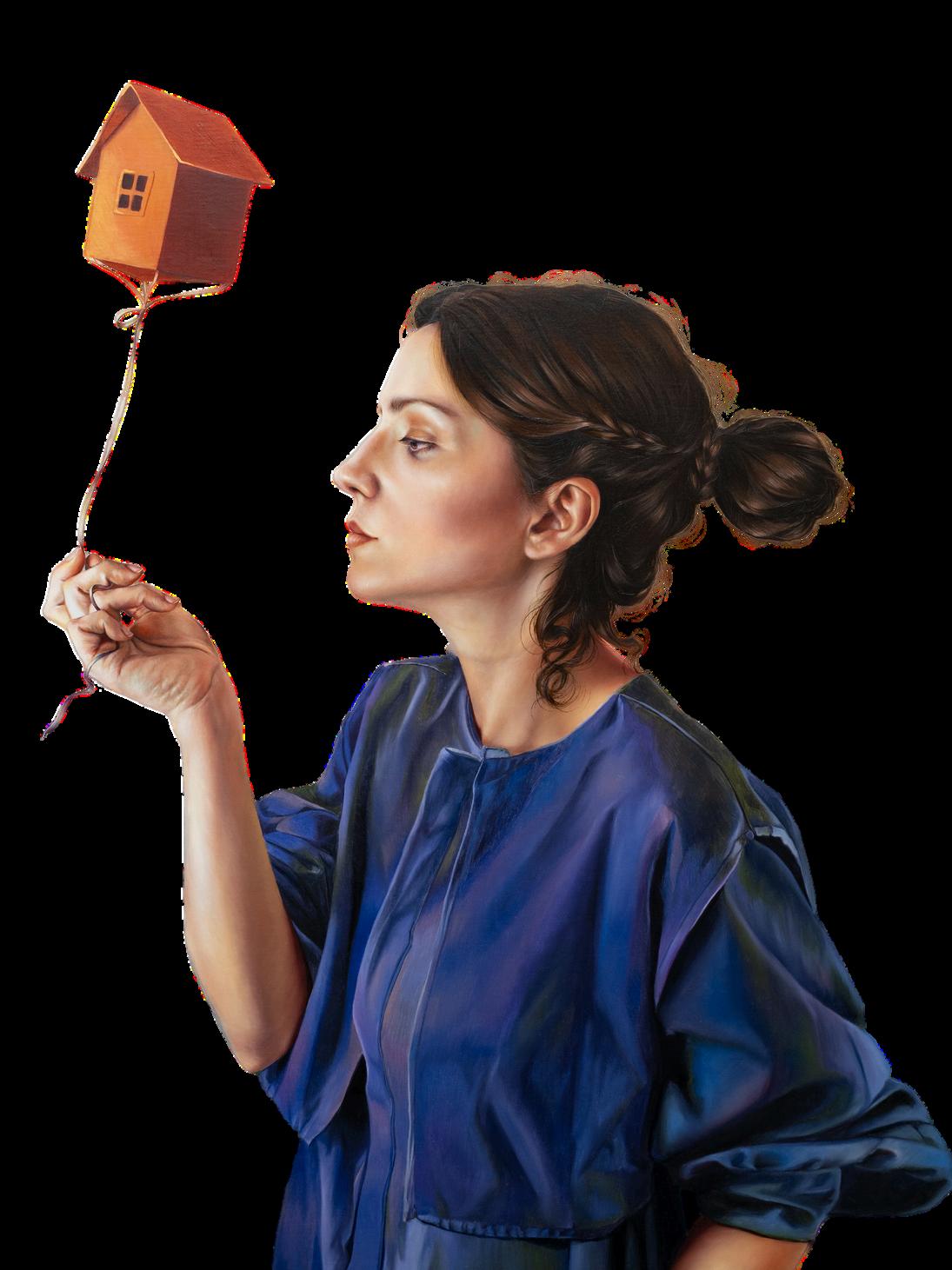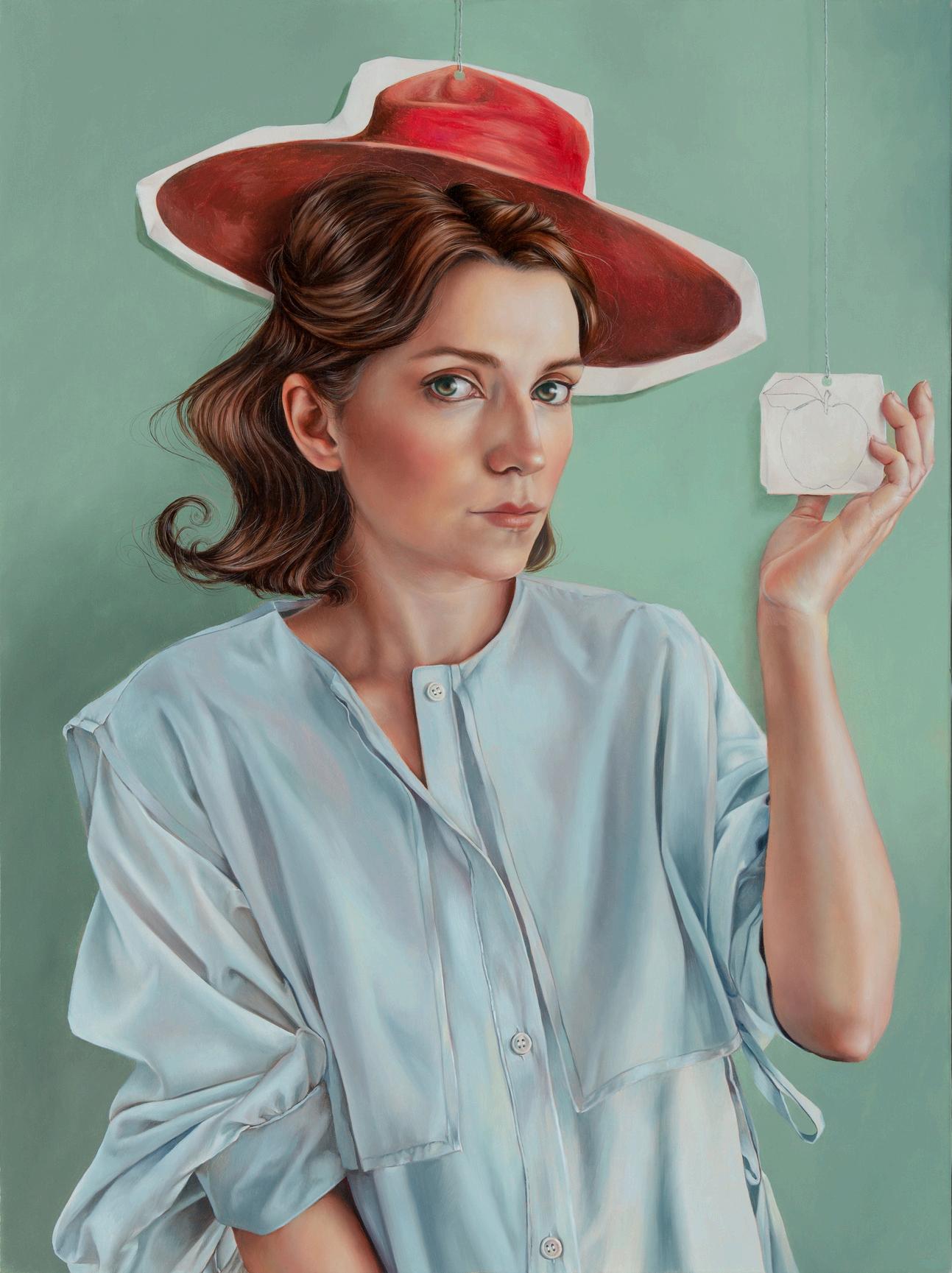

ANAMONTEIRO: ONCEUPONATIME
ANAMONTEIRO: ONCEUPONATIME
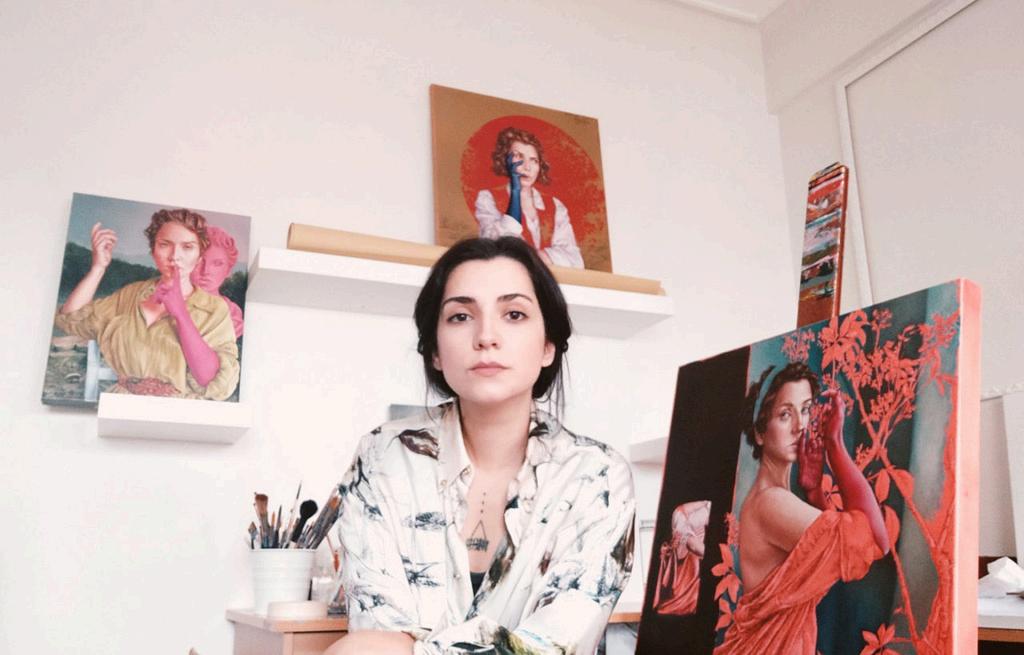
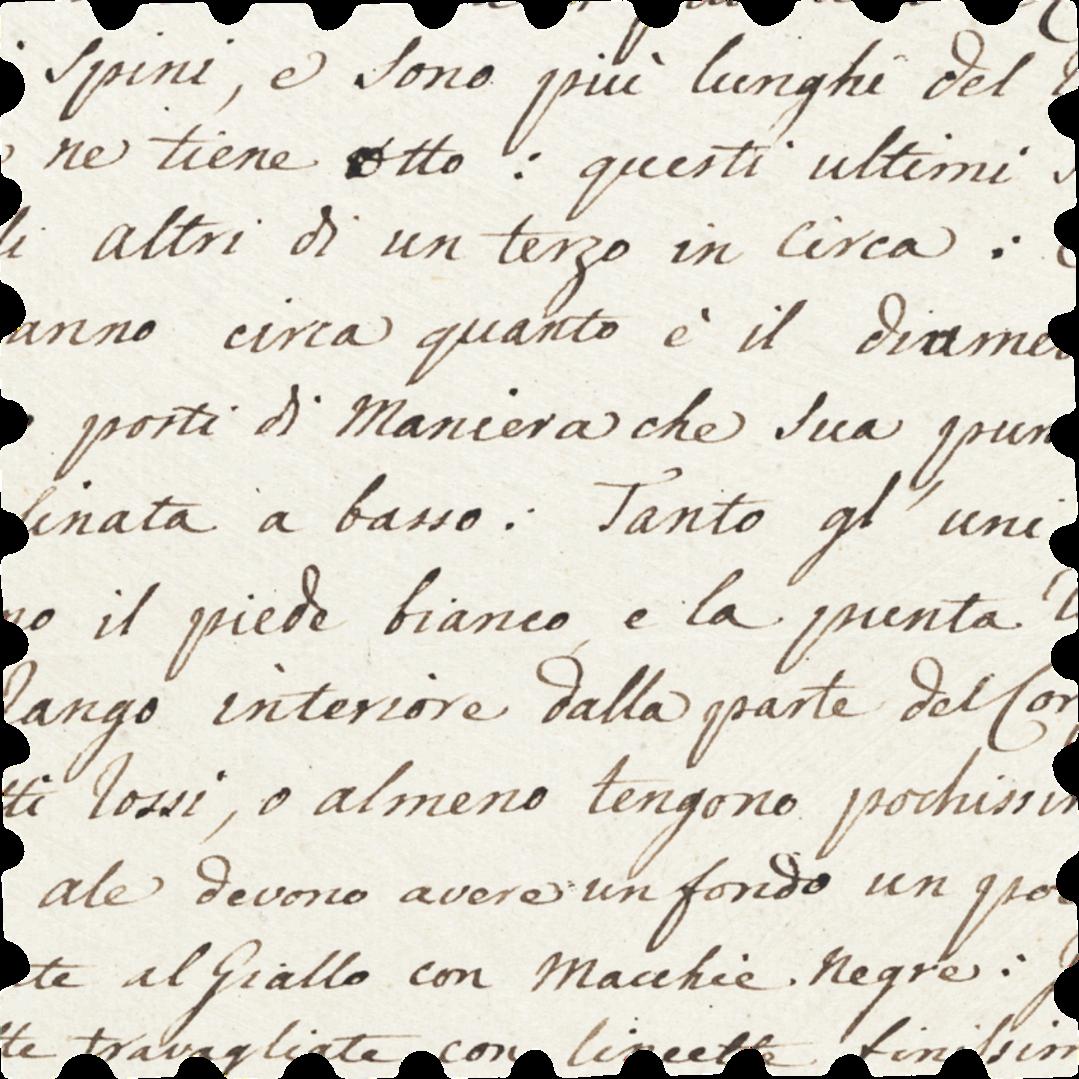
Once Upon a Time, Portuguese painter Ana Monteiro’s first solo exhibition in the US, invites you to explore the complexity of memory through a world where past and present, joy and melancholy, are beautifully and intricately interwoven. Her imaginative self-portraits are rooted in symbolism, magical realism, and evocative storytelling, creating a bridge to our collective past through references to art history, literature, allegory, and myth. Her dedication to self-portraiture stands as a declaration of identity and remembrance - expressions of self that challenge the fleeting nature of existence and anchor moments of her life, as much as our own, reflecting both the intimacy and universality of the human experience.
In this new collection, Monteiro examines the transformative power of motherhood, stating, "Since my son was born, I became very aware, and very reminiscent of my own childhood, and it has been a very acute thing to experience A multilayered feeling of both joy and sadness and everything that goes in between" These emotions are further magnified as her son attends the same school Monteiro did as a young child, a place unchanged by time, evoking vivid memories of her past. "It is quite a sensorial and emotional experience for me to be there It is like a time machine. The smells, the furniture, the light…all remain untouched, and in a split second, I’m 7 years old again," she reflects.
Monteiro captures the essence of living in a dichotomous state - dazzled by the vitality of motherhood, yet tenderly anchored by the swift passage of time. Through these paintings, she opens a portal to her personal odyssey, capturing the nuances of what it means to remember and feel, highlighting our specific emotional relationship to our own recollections of the past.
Once Upon A Time welcomes you to engage with Monteiro’s poignant reflections, allowing them to stir your own recollections and emotions as you traverse the remarkable artistic and emotional landscape she has created This journey into memory and selfhood is, in many ways, a personal fairytale - a narrative stitched from the threads of our deepest hopes, fears, and fantasies. Just as the phrase "once upon a time" evokes stories of magic and transformation, Monteiro’s work reminds us that our own lives are filled with the wonder and mystery of stories already told and those yet to be imagined.
- Lauren Ellis, Gallery Partner/Director
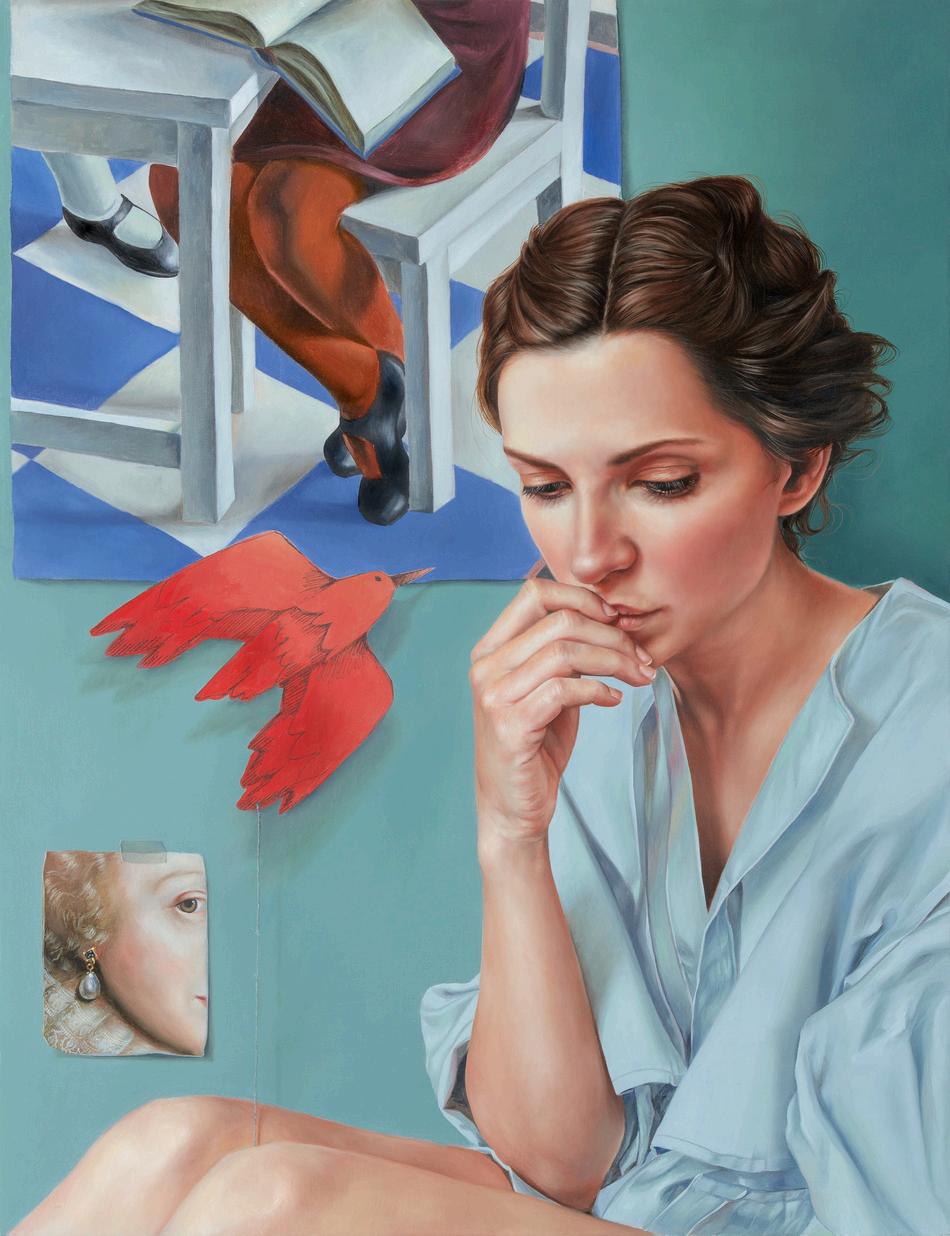
The Importance of Being Ernst Oil on linen
25 x 29.75 in
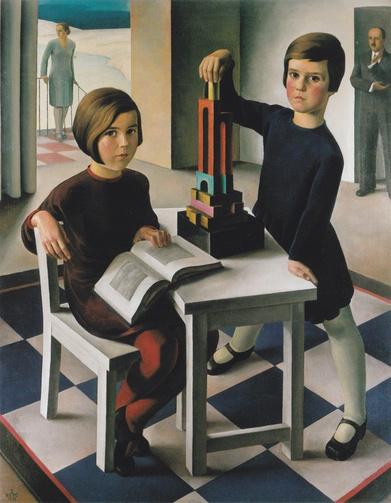
Portrait of the Keller Family, Ernst Nepo
Ernst Nepo’s 1929 painting Portrait of the Keller Family, was chosen for its link to the recent past and its evocative representation of childhood. Monteiro focuses specifically on the distinctive forms of the children’s shoes as they study and play. In a clever turn of phrase, the title of Monteiro’s painting serves as a nod to Ernst’s inspiration as well as Oscar Wilde’s play, The Importance of Being Earnest, which focuses on themes of identity, society and satire.
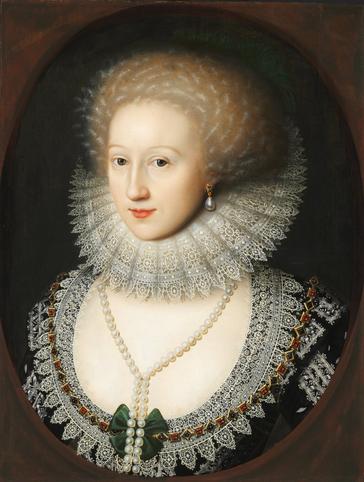
Portrait of Unknown Lady, William Larkin
William Larkin was a prominent portraitist in 17th-century England, working for the court of King James I Monteiro’s inclusion of this detail from Larkin’s Portrait of an Unknown Lady creates a bridge between the present and distant past through a woman whose identity has been lost to time Yet, 400 years later, we encounter her again and can relate to her in new and distinctive ways.
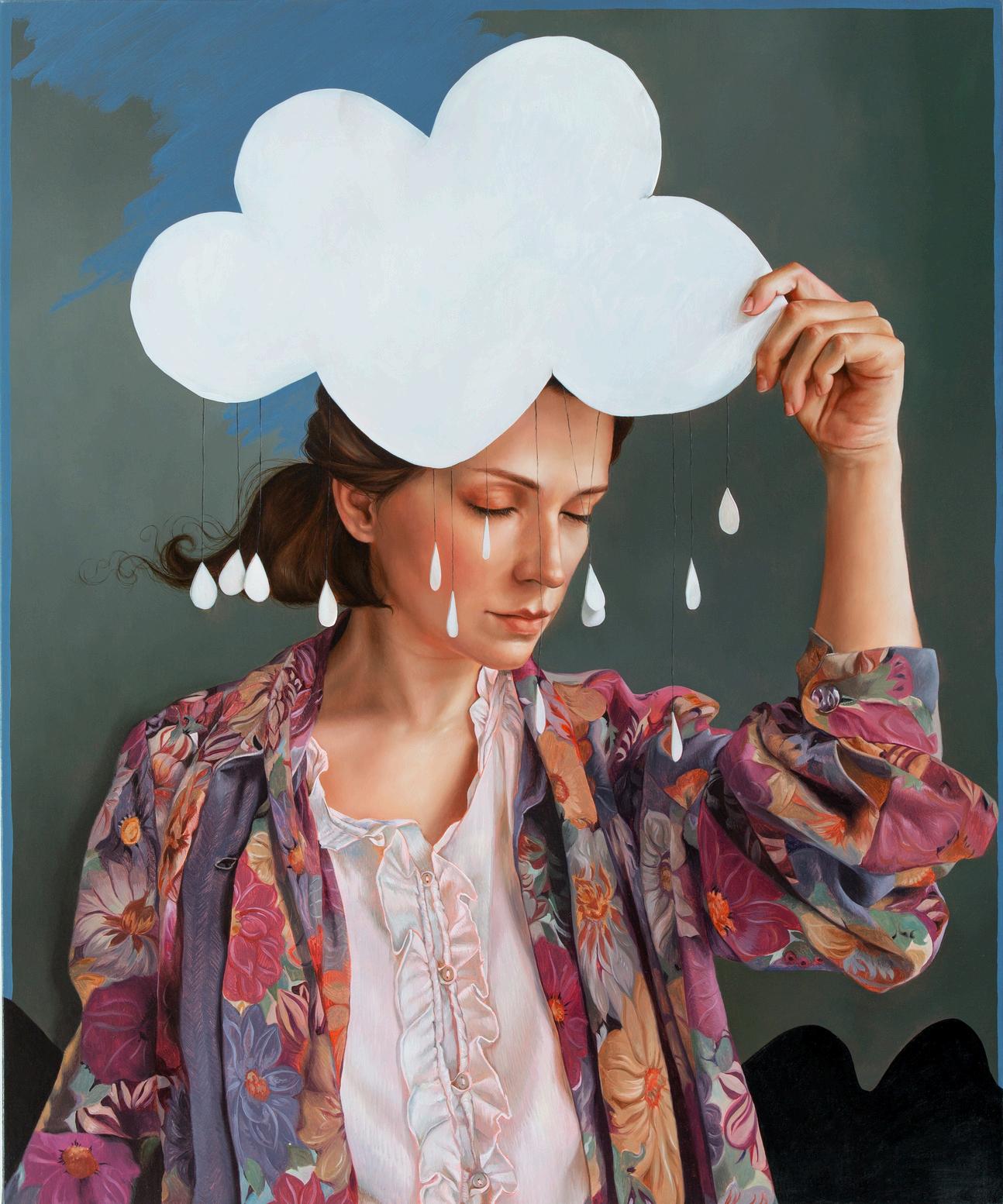
The Tempest Oil on linen
27.5 x 23 in
“I always feel that, the moment I finish a painting and release it to the world, it transmutes into a blank canvas again — open to be ‘repainted’ with as many meanings as eyes that fall upon it.”
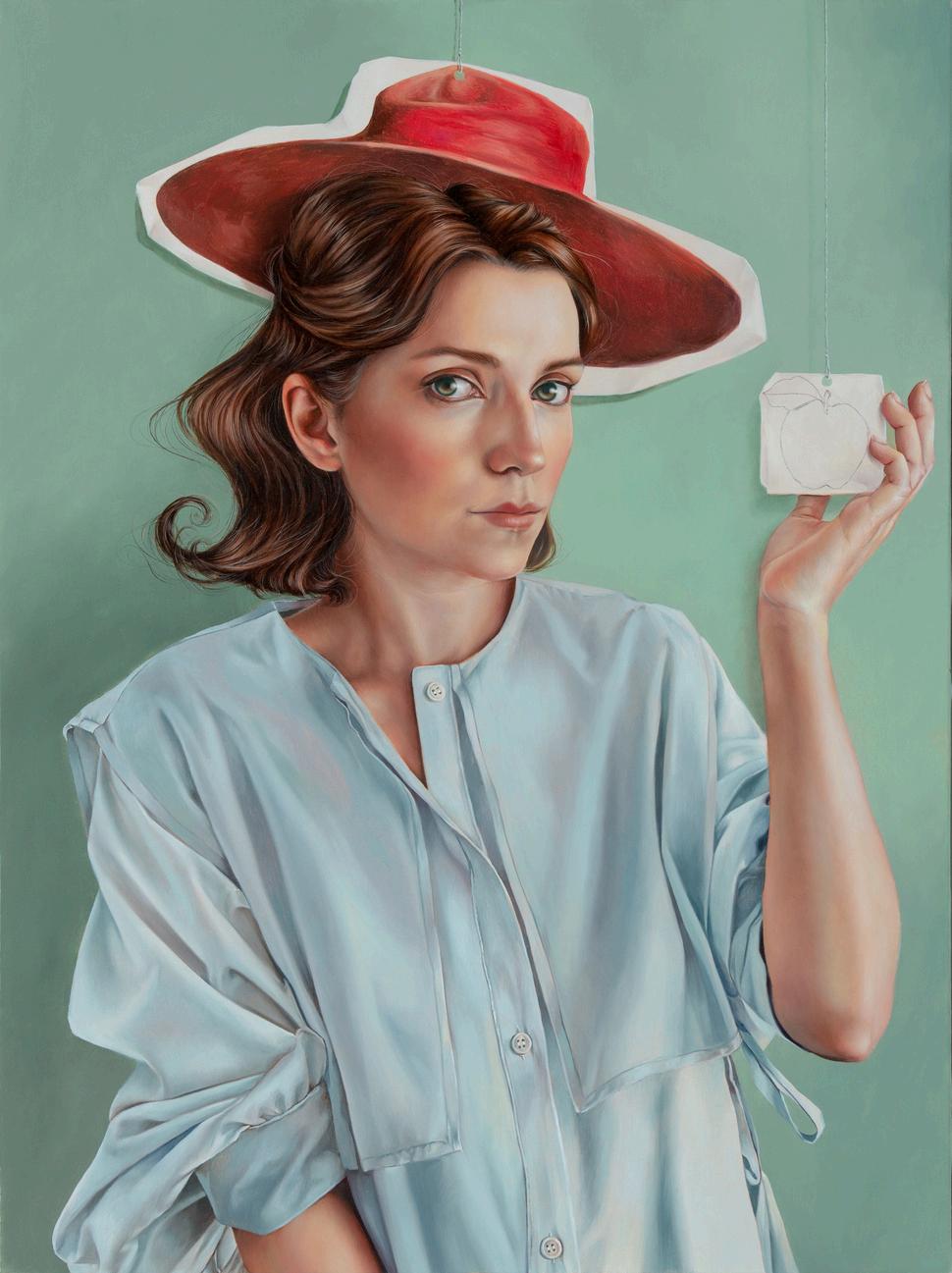
In a distant land once lived a lady
on linen
26.5 x 19.75 in
Oil
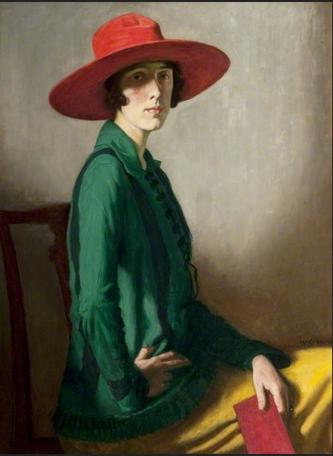
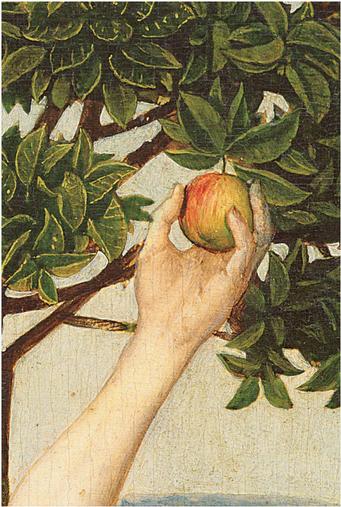
Lady with a Red Hat, William Strang
The hat referenced in Monteiro's portrait draws inspiration from Lady with a Red Hat, a striking portrait by the lesser-known artist William Strang. The portrait's subject, Vita Sackville-West, was a pioneering poet, novelist, and journalist ahead of her time who later inspired Virginia Woolf's novel Orlando: A Biography.
Apples as a Symbol in Art and History
The apple is a quintessential iconographical object with layered meaning and symbolism going back millennia. The imagery of the apple can be found in Greek and Roman mythology, throughout the Bible, in fairytales, and in modern visual culture, allowing a contemporary artist like Ana Monteiro to invoke centuries of meaning with a single form. Apples are symbolic of wisdom, immortality, and the transience of life
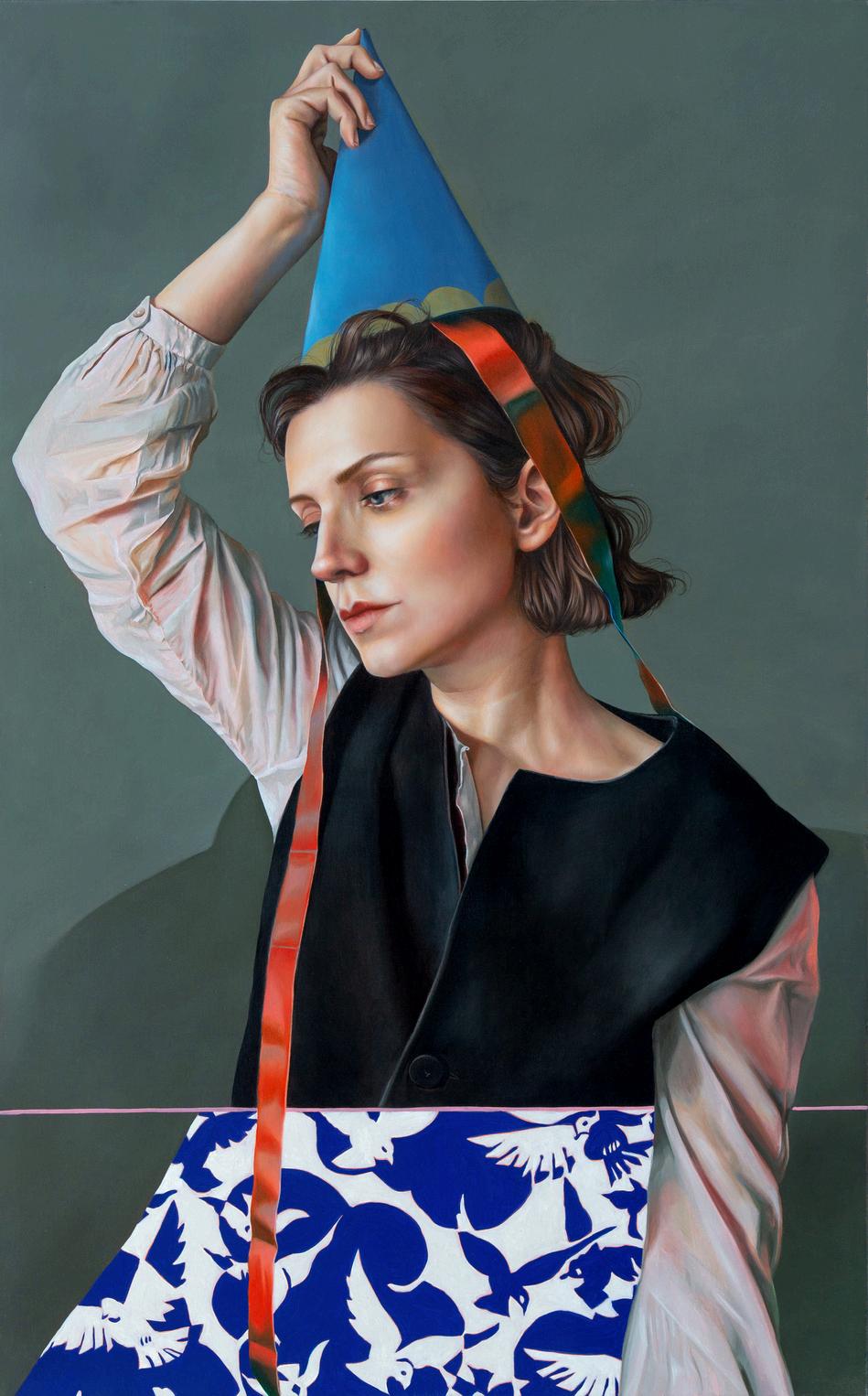
Memorabilia Oil on linen 31.5 x 19.75 in
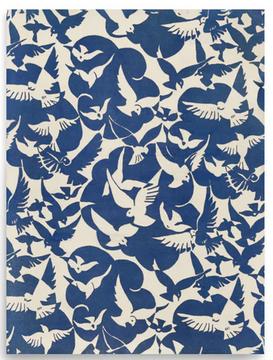
Pigeons in White and Blue, Rijksmuseum
The pattern of the skirt is borrowed from a 1928 illustration called Pigeons in White and Blue, held in the permanent collection of the Rijksmuseum. The symbology of the pigeon is based on their extraordinary memory - used to recognize routes and landmarks as they find their way home. Monteiro attempts to capture the bittersweet wonder we feel when revisiting childhood, navigating the landmarks of memory
“It’s a gentle melancholy that comes when you realize your memories are foggy, fluid. And even though they are your own, you have no real power to freeze them, preserve them, or fully retrieve them. They slip through your fingers like water.”
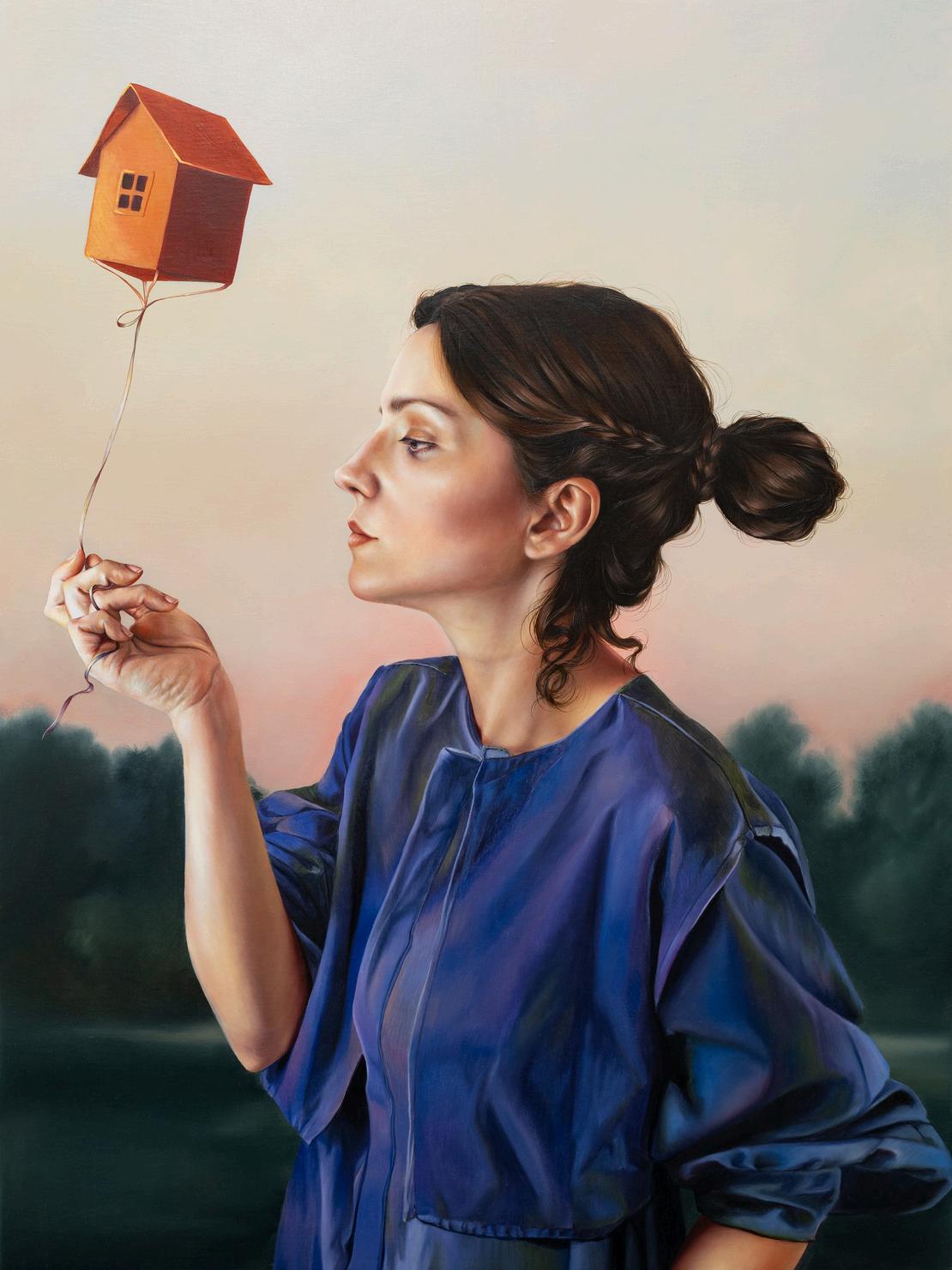
Vanishing Point
Oil on linen
31.5 x 23.6 in
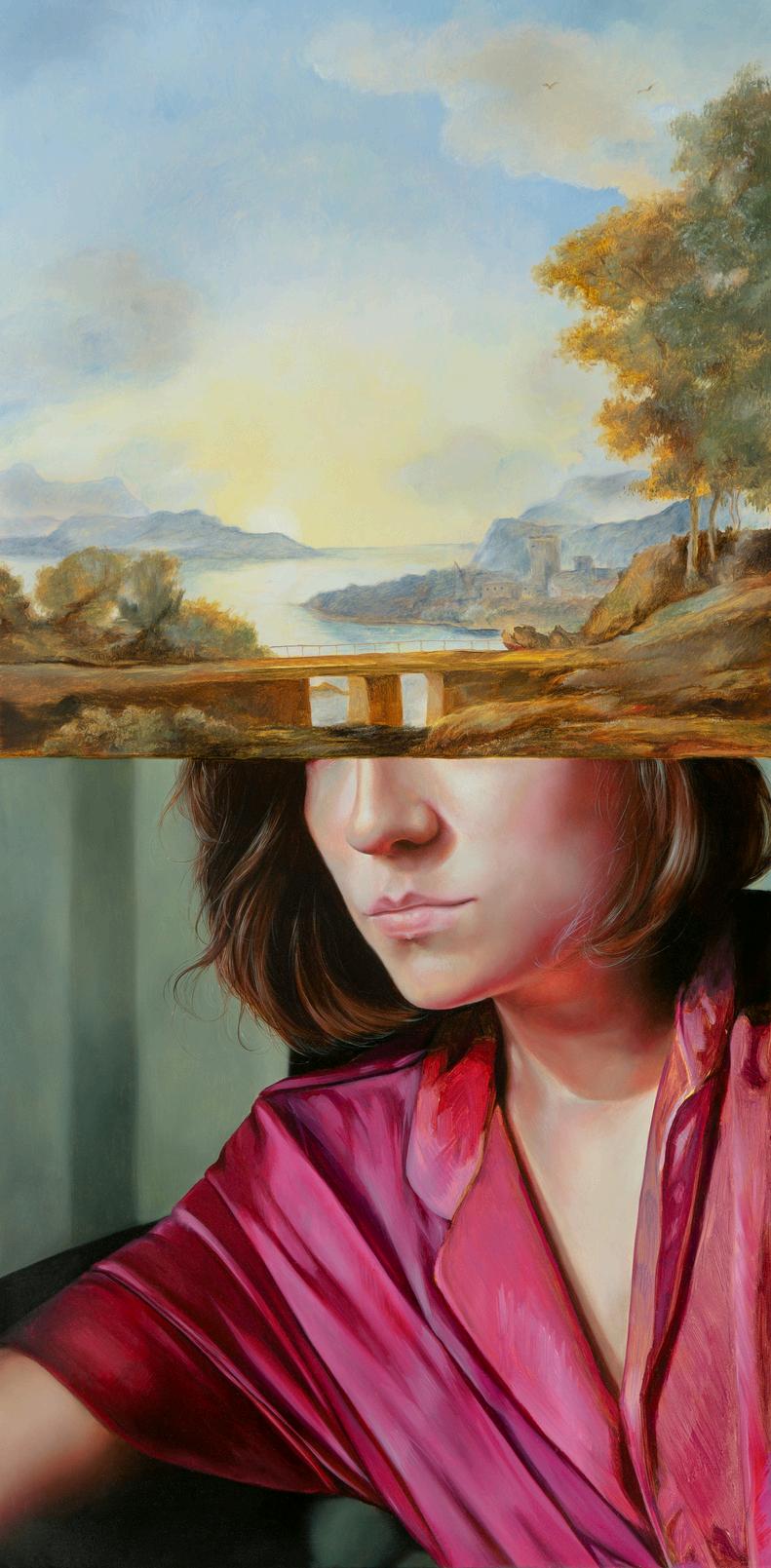
In Search of Lost Time
Oil on linen
27.5 x 13.75 in
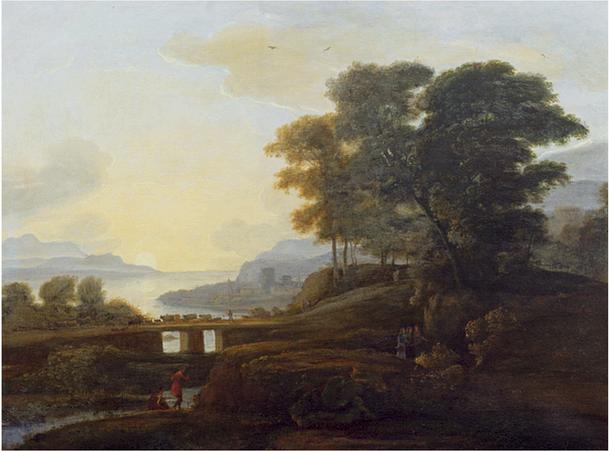
Landscape, Claude Lorraine
The landscape along the top of In Search of Lost Time is borrowed from the Baroque pastoral scenes of painter Claude Lorrain. Replicas of these paintings were commonly found in the homes of Monteiro’s relatives, representing mysterious, remote places lost to the past Drawing from these dreamlike, provincial scenes, Monteiro reimagines the river as a connection to the River Lethe, the river of forgetfulness in Greek mythology.
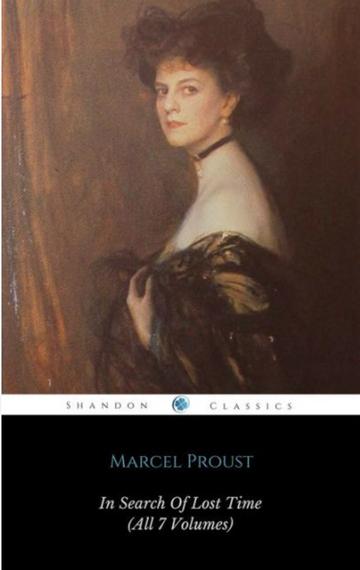
In Search of Lost Time, Marcel Proust
Monteiro adopts the title of this painting from Marcel Proust’s novel which focuses on recollections of childhood and the sensory experience of memory. Proust’s writings follow the mind wandering through a fictional distant past, untangling the complexities of identity and the evocative nature of once dormant memories.
“These paintings gather signs from the pastscraps and stitches of tenderness from every tale. They collect compass points, fables, and longings. They are tiny stories, endlessly unfolding into a thousand others, stretching backward and forward through time.”
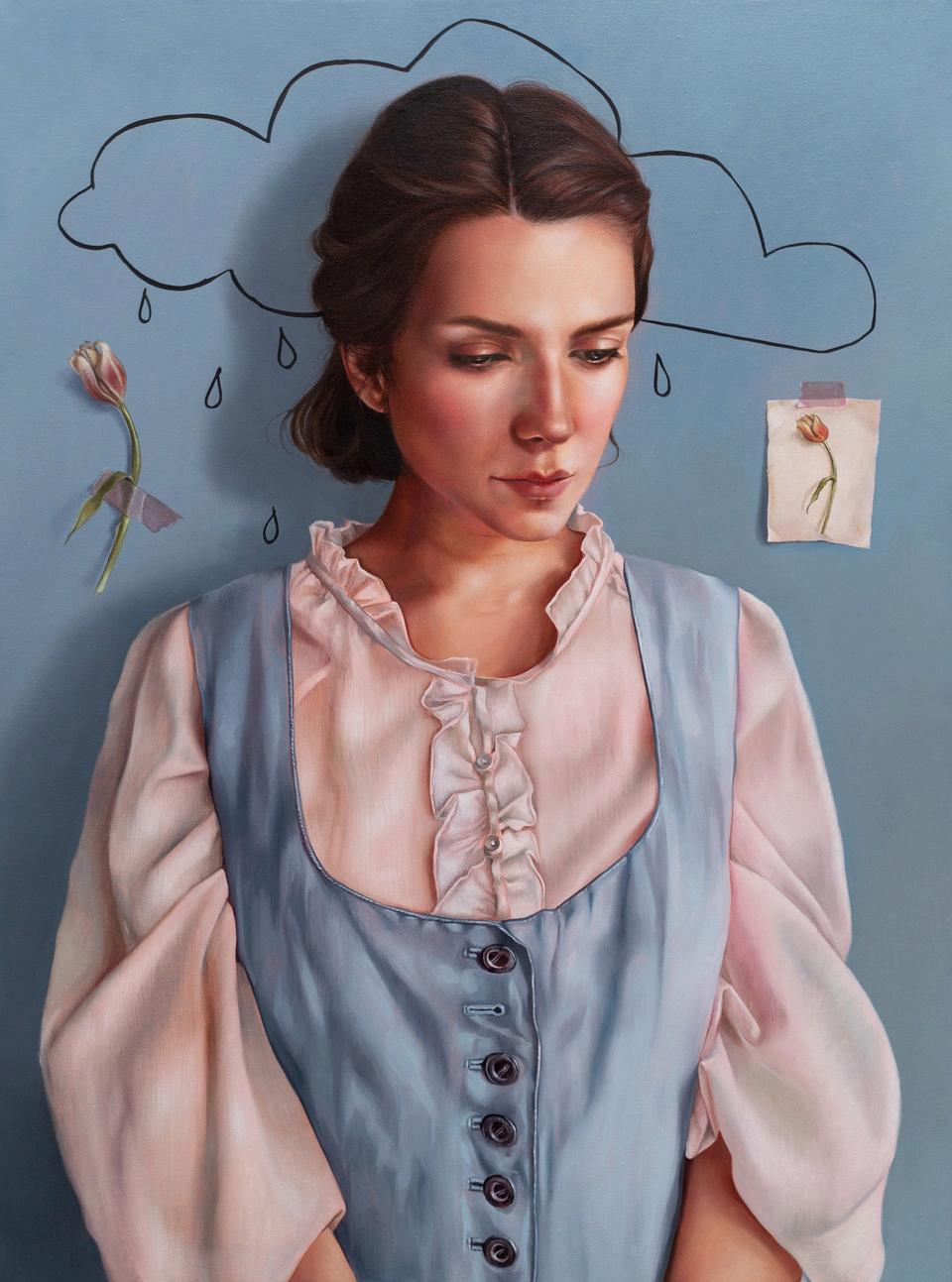
Make Believe
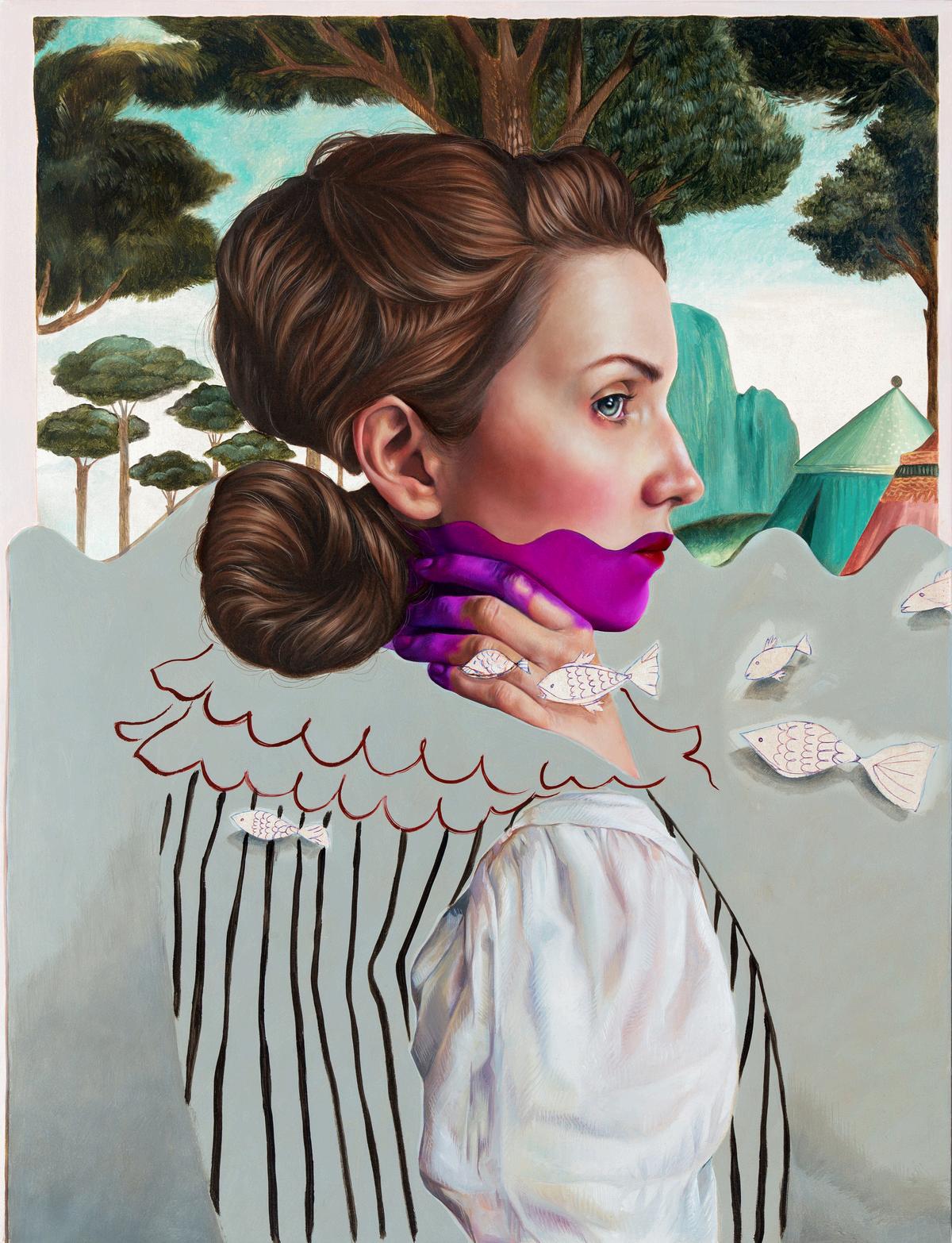
Some Hidden Soul Beneath
Oil on linen
23.75 x 18.25 in
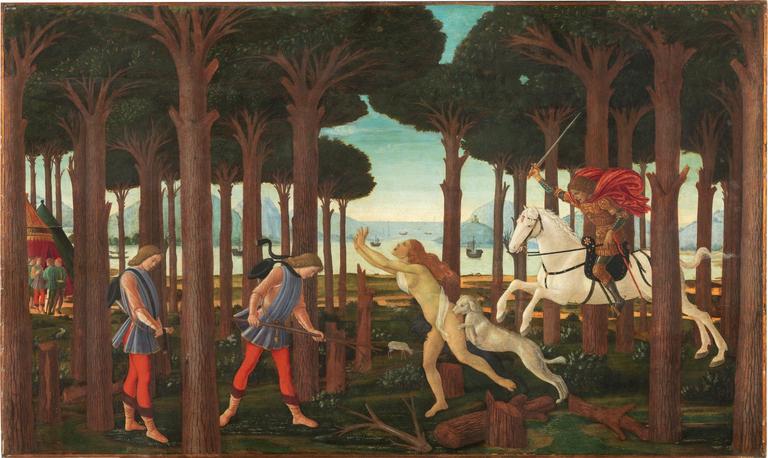
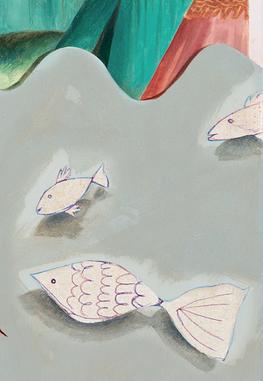
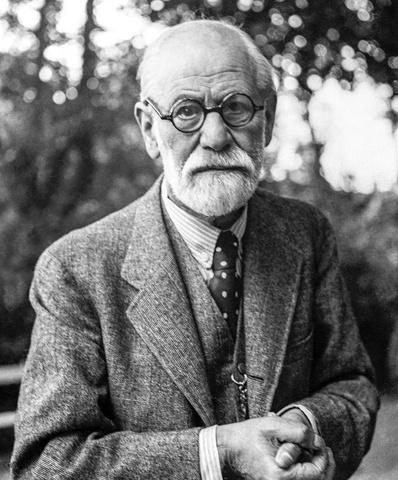
The Story of Nastagio degli Onesti, Sandro Botticelli
The background of Monteiro’s painting comes directly from the third panel of Botticelli’s painting, The Story of Nastagio degli Onesti, an illustration of a tale from The Decameron, a 14 century collection of 100 novellas This reference further connects Monteiro’s contemporary work with that of the distant past and specifically with the tradition of storytelling. th
Paper Cut-Outs
The fish in this painting originated from a collaborative exercise with Monteiro's young painting students, who contributed their own drawings to be transformed into these painted paper cut-outs - a playful connection to childhood.
Surface and Depth
Monteiro explores the Freudian concept that we carry multiple ages within us at once, where different situations trigger different versions of ourselves. These ideas of surface and depth, invoke a quote from Melville’s Moby Dick, that serves as the title of this painting: “There is, one knows not what sweet mystery about this sea, whose gently awful stirrings seem to speak of some hidden soul beneath…”
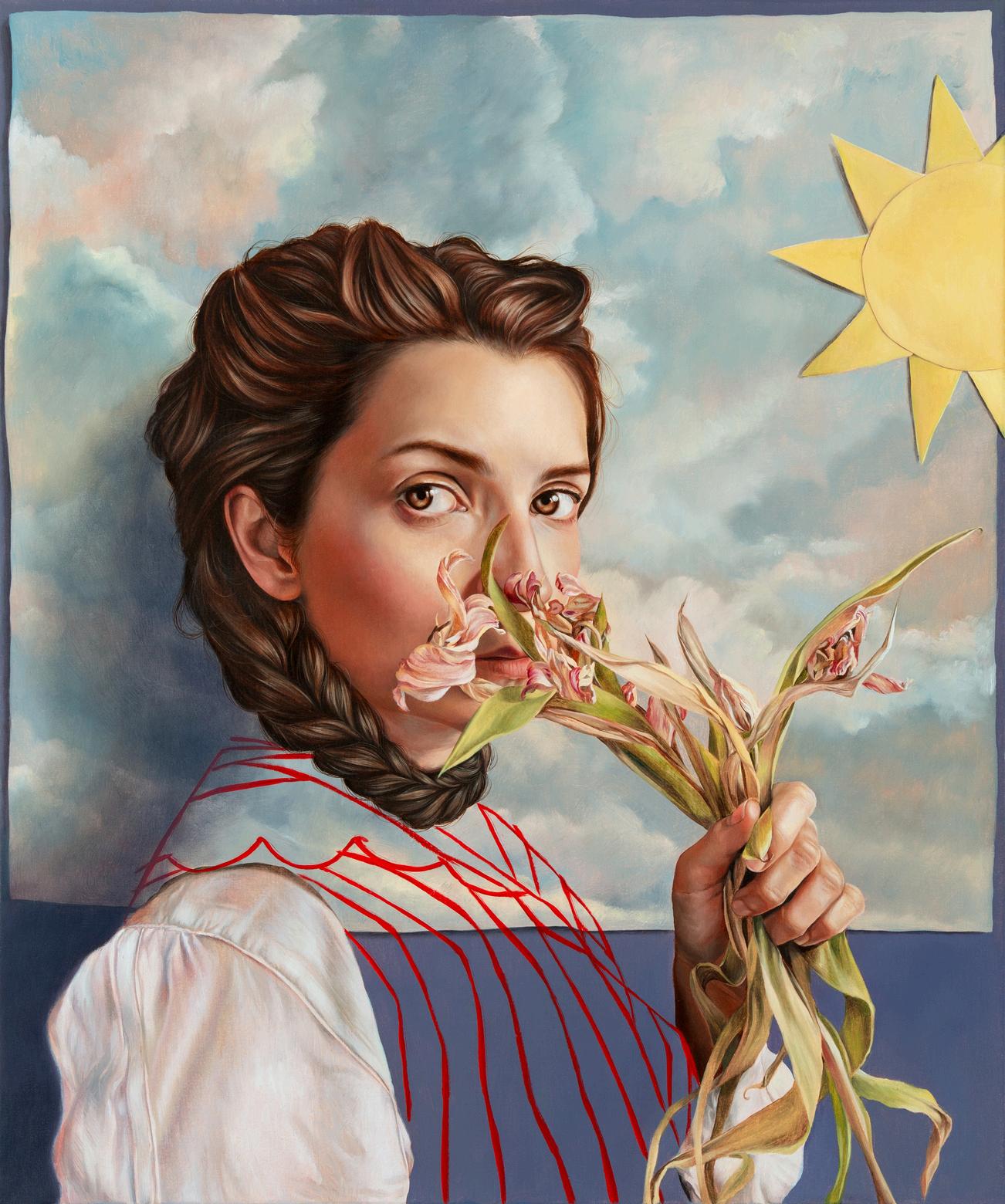
The Light of Wilted Suns
Oil on linen
23.75 x 19.75 in
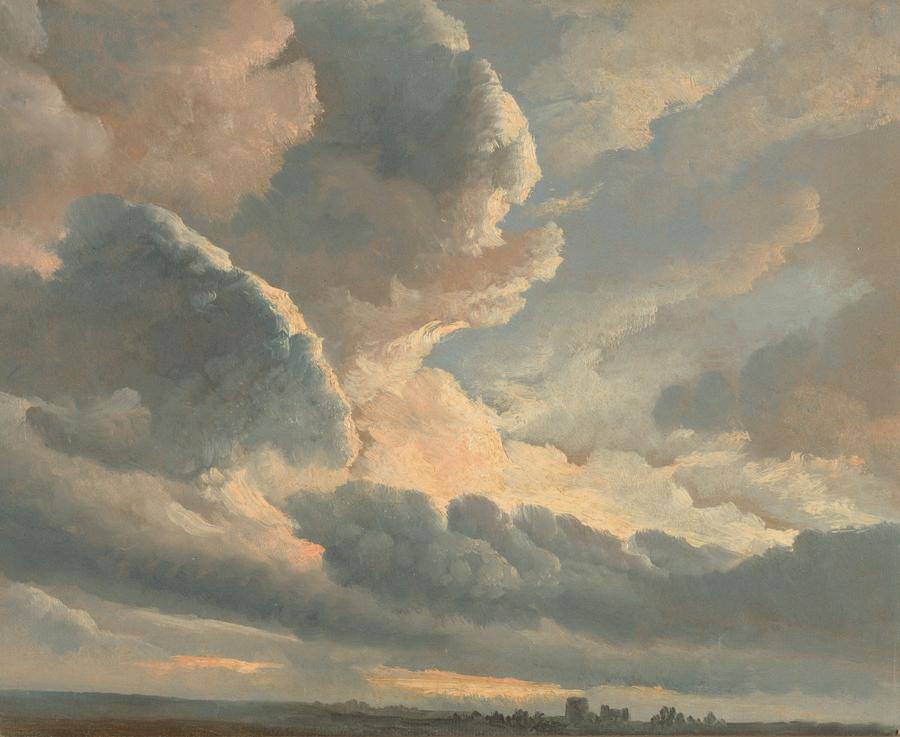
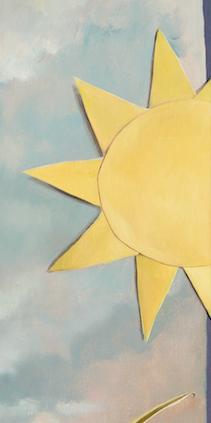
Study of Clouds Near Rome, Simon Alexandre-Clément Denis
The cloudy background of this piece is pulled from Simon Alexandre-Clément Denis’s Study of Clouds Near Rome As a lesser known artist largely forgotten to history the inclusion of his work reinforces themes of not only memory but also of forgetting. This sky carries a sense of awe at nature’s power while simultaneously evoking quietude and peace
The Symbolism of Fiction Versus Reality
The motif of paper cut-outs flows throughout this collection of work, both as a symbol of early childhood creativity and as visual representation of Monteiro’s blurring of the lines between fiction and reality Whether the sun is really present, a memory of an artistic childhood activity or just a figment of the imagination becomes part of the story left to the viewer to finish.
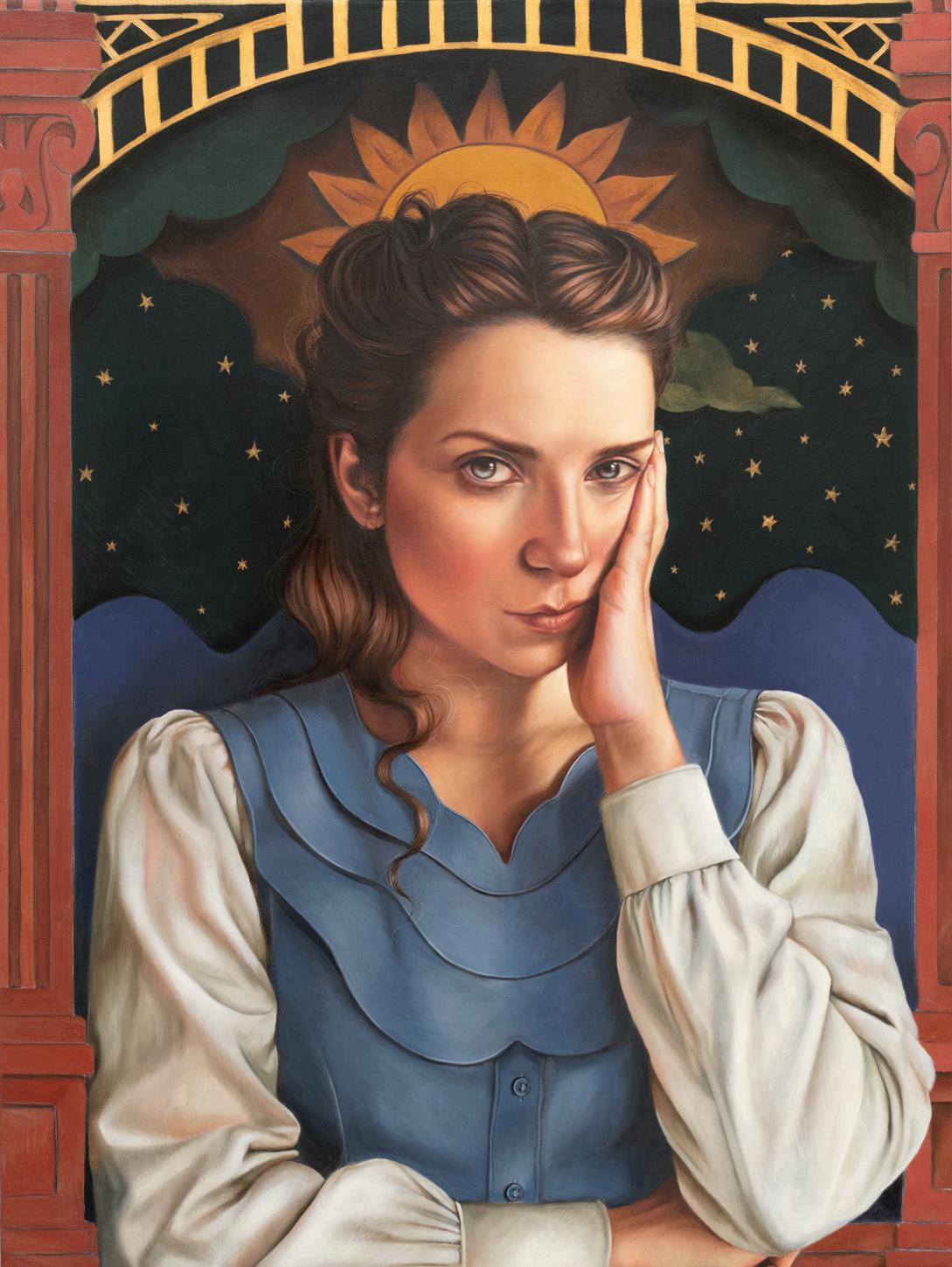
The Woolgatherer
Oil on linen
23.6 x 17.7 in
“Perhaps, the hidden reason I paint self-portraits, is tied to the urge to unfold and leave behind these breadcrumbs, these endless ‘versions’ of myself locked in amber, standing defiantly against the passing of time.”
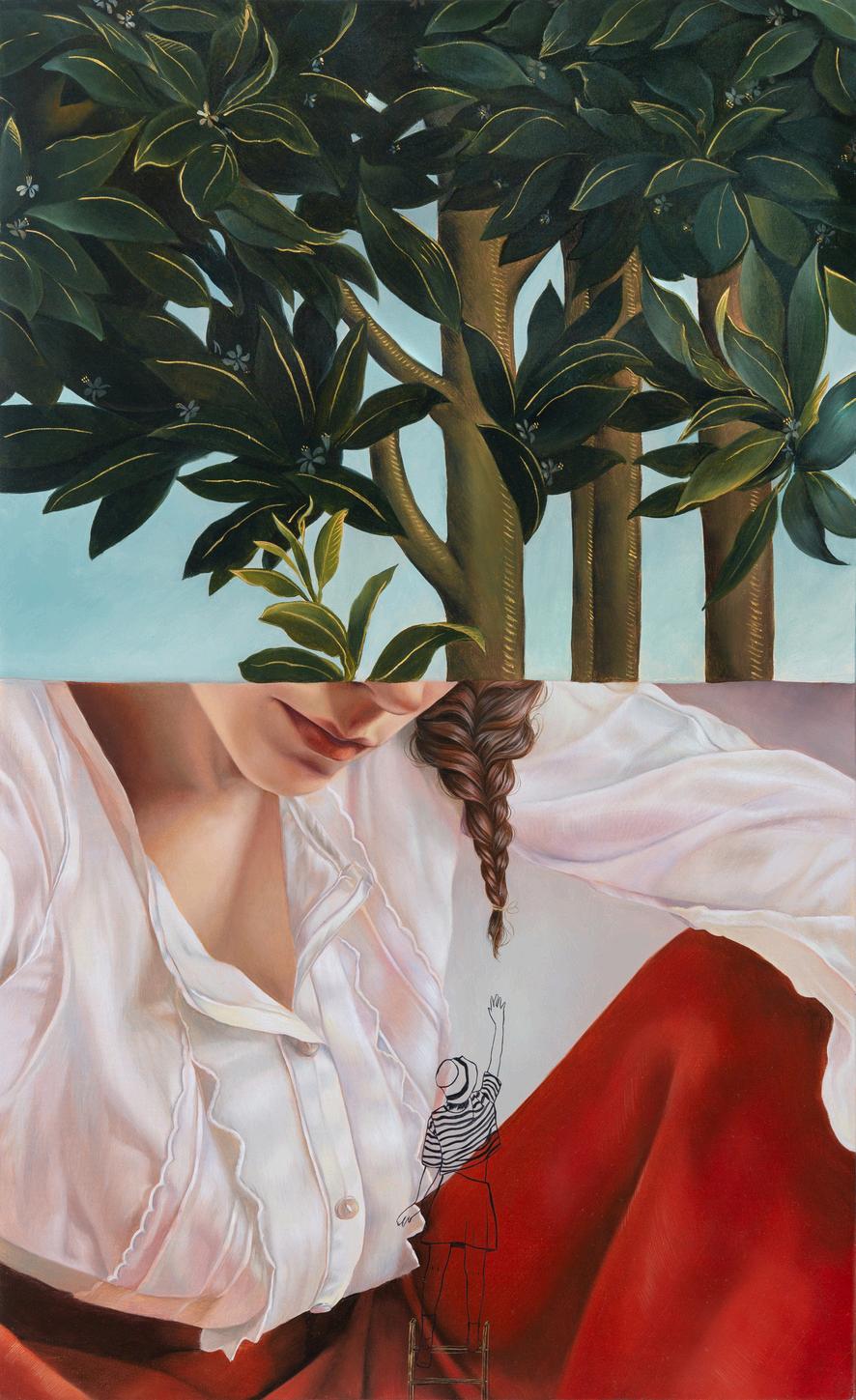
Rapunzel
Oil on linen
25.5 x 15.75 in
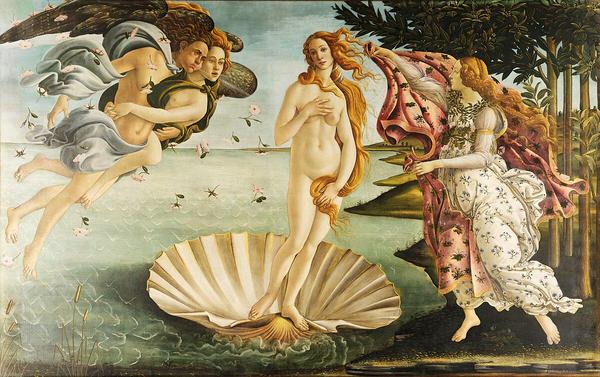

The Birth of Venus, Sandro Botticelli
This piece incorporates fragments from Botticelli’s mythological painting, The Birth of Venus, one of Monteiro’s favorite visual references Memory is again portrayed as ‘lost in a distant yesterday,’ symbolized by the repeated adaptation of the orange trees from this iconic masterpiece.
Ink Drawing of the Inner Self - Reaching
The title of this painting, Rapunzel, is a clear connection to motifs of fairy tales and these stories’ ability to help build the rich, imaginative universes that shape our youth The drawn figure in this work reflects a subconscious self, or perhaps a younger self, grasping at that dreamlike experience of childhood wonderment.
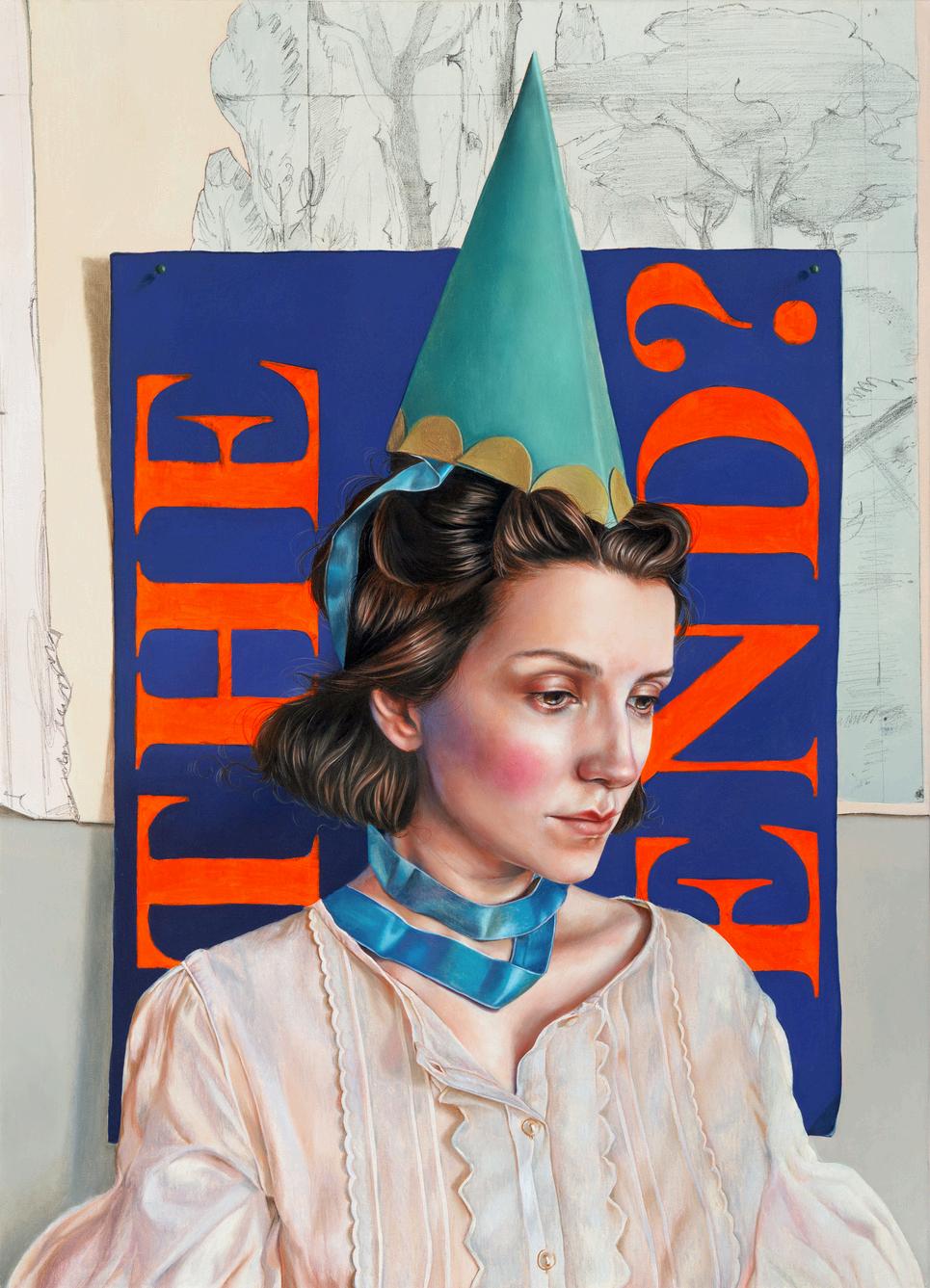
The End.
Oil on linen
25.75 x 18.5 in
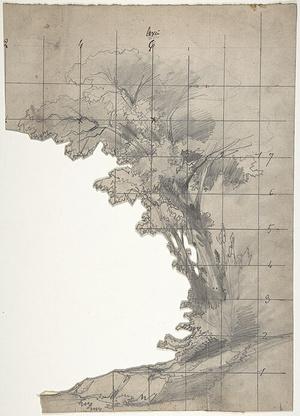

Stage Designs for the Paris Opéra, Eugène Cicéri
The pencil drawing shown in the background of this piece is borrowed from Eugène Cicéri’s stage designs for the Paris Opera as an homage to the narrative and theatrical qualities of life
The End. or The End?
Here, Monteiro delves deeper into the exploration of fiction and inner narratives. The words ‘The End?’, with a question mark reflects our condition as hesitant narrators of our own lives. We replay everything inside our heads as if it were a play or film - yet we have no omniscience We narrate the past and present with hesitation, and the future with pure guesswork.
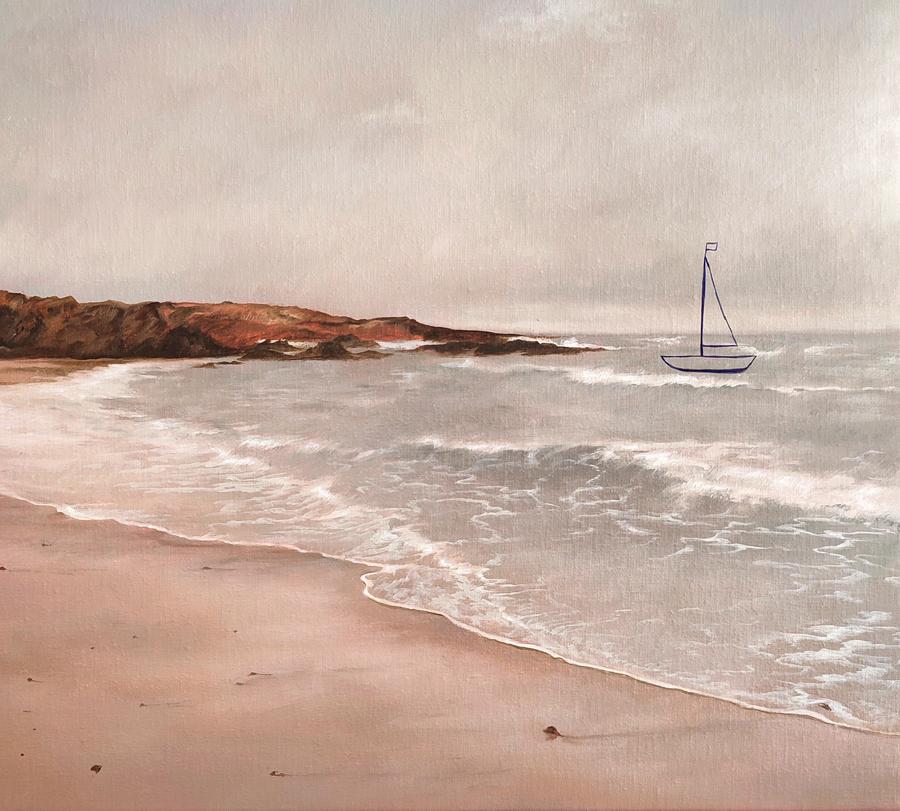
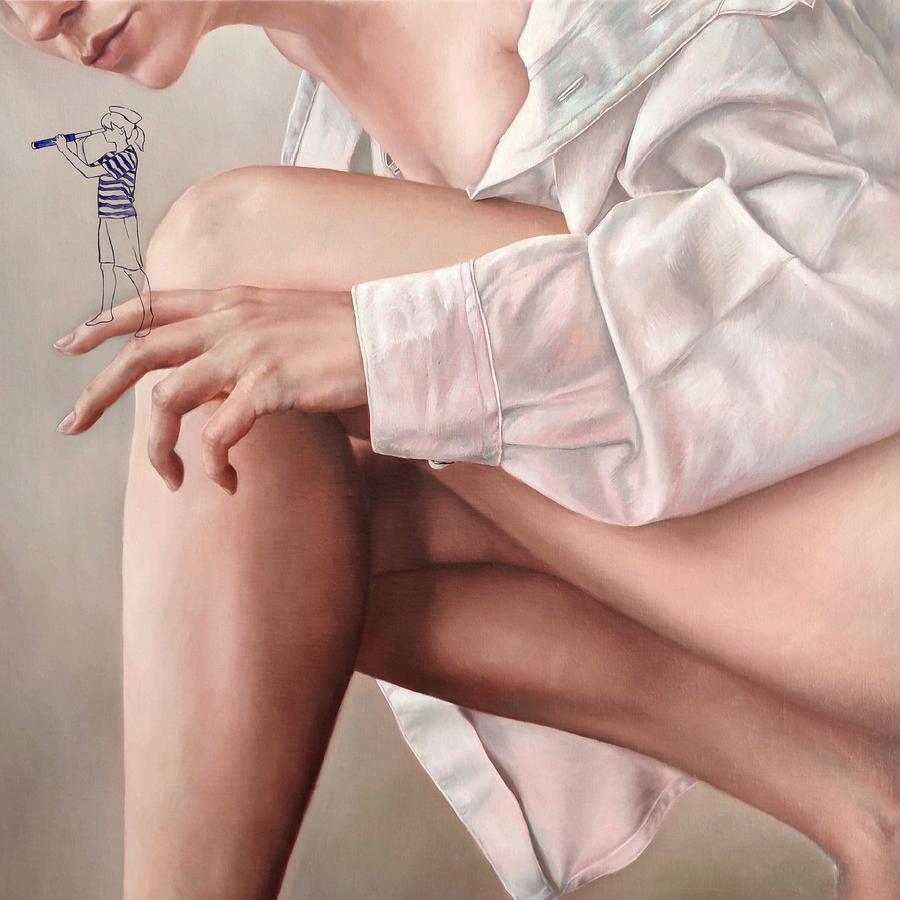
The Quiet Sense of Something Lost Oil on linen
L Panel: 14 x 15.75 in
R Panel: 19.75 x 19.75 in
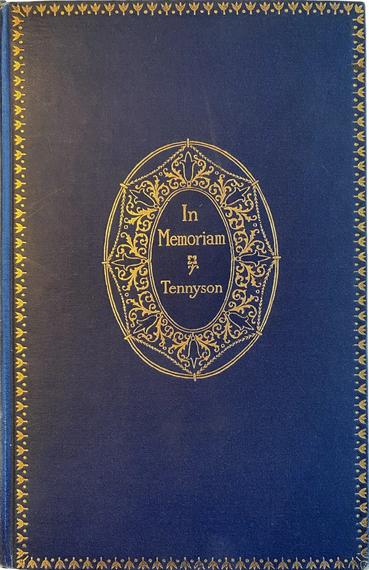
“The Quiet Sense of Something Lost,” Alfred Tennyson
The title of this piece is borrowed from a poem by Alfred Tennyson Both poem and painting tell a tale of oblivion and remembrance. Both search for those close to forgotten places, or places left behind, within ourselves. It is a constant effort to protect and save those versions of ourselves from disappearing behind a veil of forgetfulness

Ink Drawing of the Inner Self - Searching
The inked figure emerges once more in this diptych, again rendered miniaturized and transparent. She, like those forgotten places, has slowly faded, yet is simultaneously still searching, as she gazes out from one canvas to the other, looking for moments past that have begun to fade away and those places we can no longer find
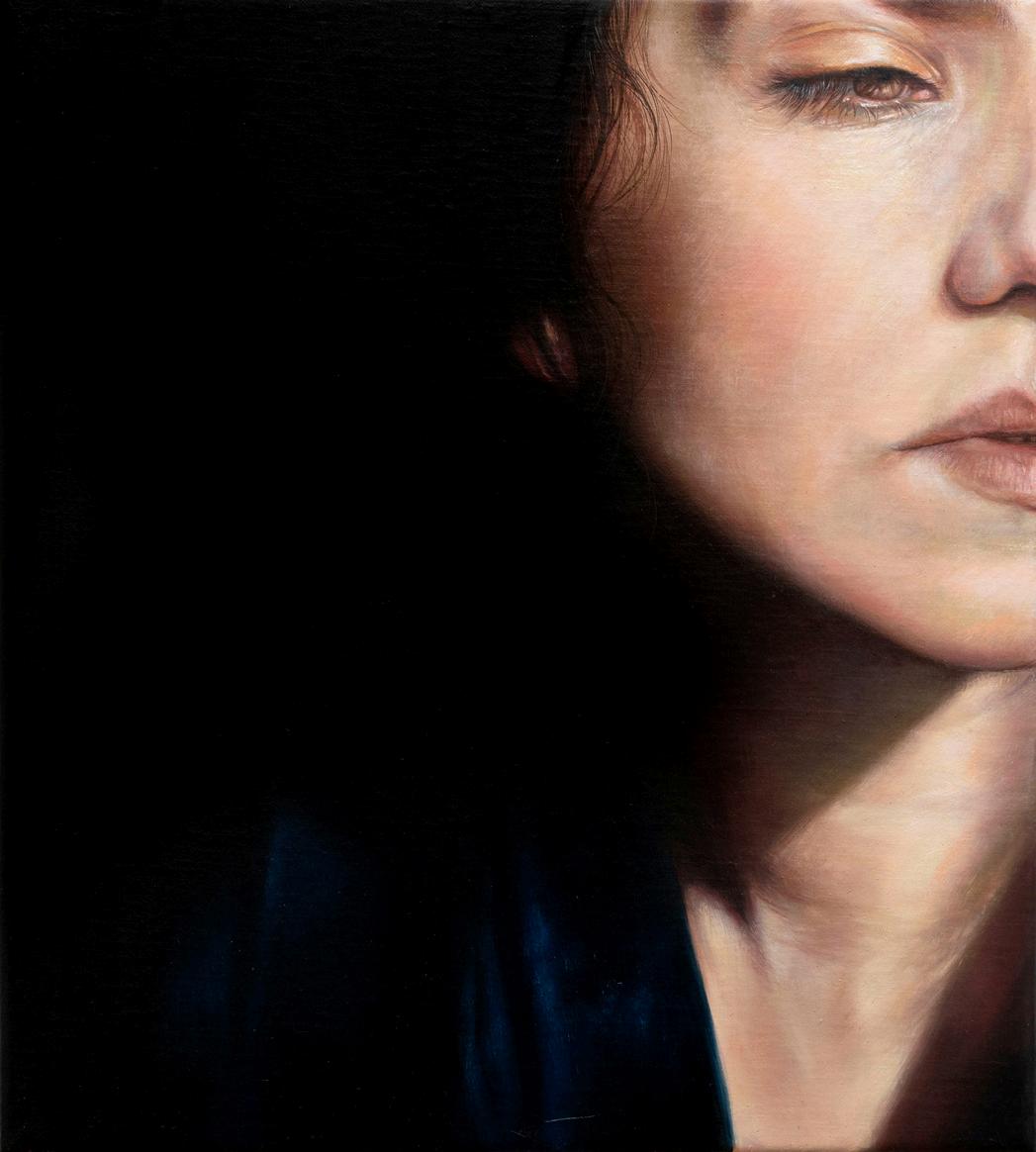
Portrait of an Unknown Lady II
Oil on linen
11 x 9.84 in

Portrait of an Unknown Lady revisited
This small piece came to life before others in this collection and was in Monteiro’s studio as she began working on The Importance of Being Ernst. Their playful connection is found in the detail of Larkin’s 17th-century Portrait of an Unknown Lady The image of a woman whose identity has been lost, and who is being repainted over 400 years later, is mirrored in the composition of a contemporary self-portrait, tying the themes of identity and memory together
“I think we are trapped in this curious state: excited for what lies ahead, mesmerized by the beauty of now, and sad because now passes so quickly that we start longing for it already.”
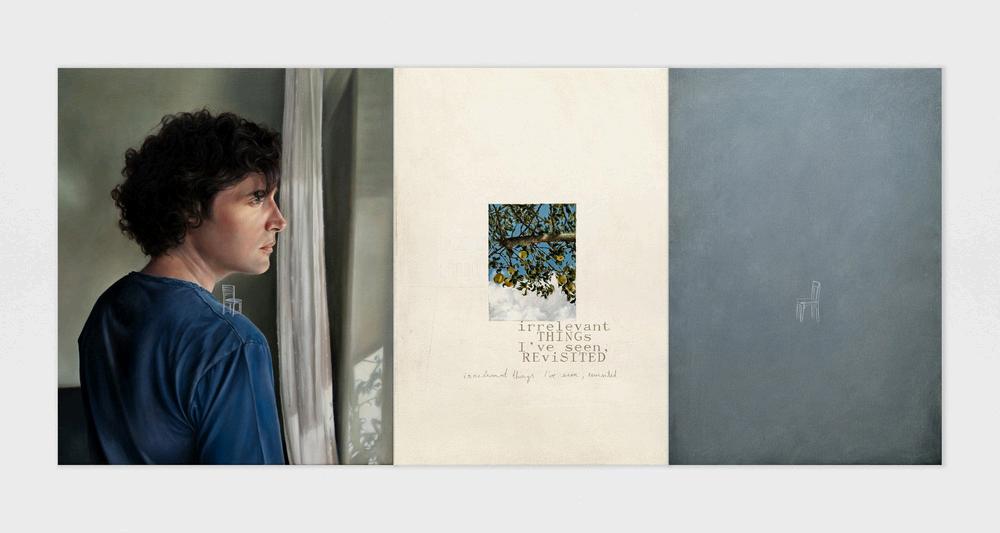
Irrelevant Things (Triptych)
Oil on linen
25.6 x 57 in
ANAMONTEIRO: (PORTUGUESE,B.1990)
Ana Monteiro is a figurative artist whose practice is a reflection upon the concept of the Self, through an aesthetic that is shaped around the idea of symbolism and magical realism. The existential angst, and the infinite wonderful ways through which we try to root ourselves amid the great unknown, are a constant feature of her work
In her creative process, she mingles the contemporary with the distant past: starting with a photographic and digital composition process, she then dives into a more “classical” approach, building her paintings through several layers – from the “imprimatura” to the “verdaccio” underpaintings, until the final veils of vibrant color. All these steps, although time-consuming, allow her to create figures and environments of great detail and vibrancy, and have, at the same time, a symbolic charge by creating a connection with the ways of the past. The importance of memory, both individual and collective, is a constant presence in her works In them, this link is made both by the painting techniques as by the integration in the artworks of subtle details that take us back to visual references from our collective pictorial past.
Through her imagery, she creates tales about the dyed skin of our identity: the memory and the time behind it. The Reality, the fictions, and the impenetrable gap that rips between the two. The “multiphrenia” of the self, the masks. The real and built identities: the cocoons that protect us from the Other and the walls that hide us from ourselves. The fog that dampens the past and the pitch-black
that blinds the days yet to come And us In the middle of everything Lucid and blind. Lost, proud, and naked. Trying, wonderfully, to understand. She contemplates the discomfort and makes it an aesthetic object, so it may be contemplated as well: as form, as thought, as wonder.
From an early age, sketchbooks and pencils were her companions: windows through which she created worlds where she immersed herself. She holds an MA and a BA in Painting from the Faculty of Fine Arts of the University of Porto With her master’s degree, she developed a thesis that interweaves the pictorial portrait with the idea of social mask.
Monteiro cites many influences in her journey: from Botticelli to Christian Schad and Félix Vallotton and finds in the poetry of Fernando Pessoa an inexhaustible source of inspiration. Writing is actually a crucial part of her creative process: the narratives she wants to build are grounded in both pictorial and written form, interweaving words, and brushstrokes.
Her work has been mentioned in several art and cultural publications, like Realism Today, Artit, The Guided Artist, RUA Magazine, e-Cultura, Mod Portrait 2020 Special Catalog, amongst others. Ana’s paintings have been featured in numerous group and solo exhibitions since 2011 and are represented in several private and corporate collections.

Published on the occasion of the exhibition Once Upon a Time, October 2025
Exhibition organized by CK Contemporary Research and writing by Anna Eby and Lauren Ellis
2025 CK Contemporary
All rights reserved. No part of this book may be reproduced or transmitted in any form without written permission from CK Contemporary.
